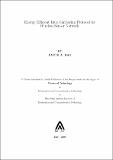Please use this identifier to cite or link to this item:
http://drsr.daiict.ac.in//handle/123456789/223| Title: | Energy efficient data gathering protocol for wireless sensor network |
| Authors: | Srivastava, Sanjay Rao, Parth A. |
| Keywords: | Sensor networks Wireless communication systems Wireless LANs EIGRP Computer network protocol Routers Computer networks Wireless communication systems Quality control |
| Issue Date: | 2008 |
| Publisher: | Dhirubhai Ambani Institute of Information and Communication Technology |
| Citation: | Rao, Parth A. (2008). Energy efficient data gathering protocol for wireless sensor network. Dhirubhai Ambani Institute of Information and Communication Technology, v, 56 p. (Acc.No: T00186) |
| Abstract: | Wireless Sensor Network is made up of hundreds and thousands of miniature electronic devices called node, which have sensors built on them. Functionality of a sensor is entirely application dependent. They can perform a large number of functions from measuring the forces of nature like temperature, humidity, geophysical activity, sound vibrations to motion detection and military surveillance. Apart from sensing or measuring, the nodes are responsible for efficiently collecting the sensed data by performing appropriate activities on the collected data and there by weeding out redundant data so as to reduce transmission overload on nodes. Thus the nodes are responsible for gathering data and routing the data to the base station. Data Gathering can be performed in number of ways after nodes are deployed in the sensing field depending on their application. The manner in which nodes are deployed in the sensing field also affects the lifetime of the sensor network. It is not always possible that all nodes after deployment in the sensing field are able to communicate with the base station. Moreover efficient utilization of the energy is a must for sensor nodes, because these sensors are battery powered devices, and after they are deployed in the sensing field it is not feasible to change the battery of the nodes. So energy preservation of nodes in sensor network is a crucial requirement to be taken care of. The other prime matter worth considering is that during the whole life time of the sensor network care should be taken that load distribution on all the nodes in the sensing field is equal. All nodes should either die randomly at random location in the sensing field at random time intervals, or all nodes should start dying at more or less the same time. We have proposed an energy efficient protocol for data gathering in wireless sensor networks, which through hierarchical cluster formation reduce the number of high energy transmissions per round of data gathering and takes care of the load balancing issue by randomized rotation of the cluster heads. Routing of data is done in multi-hop fashion to ensure that the most remotely located node is also able to communicate with the base station through the best available intermediary nodes. |
| URI: | http://drsr.daiict.ac.in/handle/123456789/223 |
| Appears in Collections: | M Tech Dissertations |
Files in This Item:
| File | Description | Size | Format | |
|---|---|---|---|---|
| 200611050.pdf Restricted Access | 1.11 MB | Adobe PDF |  View/Open Request a copy |
Items in DSpace are protected by copyright, with all rights reserved, unless otherwise indicated.
